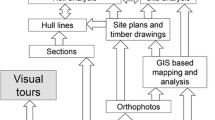Abstract
Until recently close range photogrammetry has been exclusively done with dual or single cameras using a methodology termed stereoscopic photogrammetry. Likewise, it has been the only photogrammetric methodology used underwater. Convergent photogrammetry offers a faster, less expensive and more accurate methodology for the recording of underwater historical sites. The principles common to both forms of photogrammetry are reviewed so the differences stand out more clearly to the reader. Two examples of the application of convergent photogrammetry are presented—a test case conducted in a controlled environment and an actual field problem—so as to make the theory and method more understandable.
Similar content being viewed by others
References
Baker, P. E., and Jeremy N. Green 1976 Recording Techniques Used During the Excavation of the Batavia. International Journal of Nautical Archaeology and Underwater Exploration 5(2): 143–158.
Bass, George F., and Donald M. Rosencrantz 1972 Submersibles in Underwater Search and Photogram-metric Mapping. In Underwater Archaeology—A Nascent Discipline, pp. 271–283. UNESCO, Paris.
Bell, John 1986 Underwater Stereo-Photogrammetric Recording: A Pilot Project—Red Bay, Labrador. Association of Preservation Technology 18(1+2):112–114.
Burns, John A. 1991 CAD-Photogrammetry: A Powerful Documentation Tool. CRM 14(3):4–5.
Cederlund, Carl O., and Carl Ingelman-Sundberg 1973 The Excavation of the Jutholmen Wreck, 1970–71. International Journal of Nautical Archaeology and Underwater Exploration 2(2):301–327.
Drager, D. L., and Thomas R. Lyons 1985 REMOTE SENSING, Photogrammetry in Archaeology: The Chaco Mapping Project. National Park Service, U.S. Department of the Interior, Albuquerque, New Mexico.
Green, Jeremy, P. E. Baker, B. Richards, and D. M. Squire 1971 Simple Underwater Photogrammetric Techniques. Archaeometry 13(2):721–732.
Jacobs, H., and J. Moir 1976 Photographic Survey of the HMS Sapphire. International Journal of Nautical Archaeology and Underwater Exploration 5(4):353–355.
Lyons, Thomas R., and T. E. Avery 1977 REMOTE SENSING: A Handbook for Archeologists and Cultural Resource Managers. U.S. Government Printing Office, Washington, D.C.
Millon, Rene, R. B. Drewitt, and George L. Cowgill 1973 Urbanization at Teotihuacán, Mexico. Vol. 1, The Teotihuacán Map, Part Two. University of Texas Press, Austin.
Milne, P. H. 1980 Underwater Photography and Television. In Underwater Engineering Surveys, pp. 210–247. Gulf Publishing, Houston, Texas.
Tchernia, A. 1977 A Roman Wreck of La Madregue de Giens. Progress in Underwater Science 3(n.s.): 19–24.
Author information
Authors and Affiliations
Rights and permissions
About this article
Cite this article
Garrison, E.G. Recent advances in close range photogrammetry for underwater historical archaeology. Hist Arch 26, 97–104 (1992). https://doi.org/10.1007/BF03374518
Published:
Issue Date:
DOI: https://doi.org/10.1007/BF03374518




